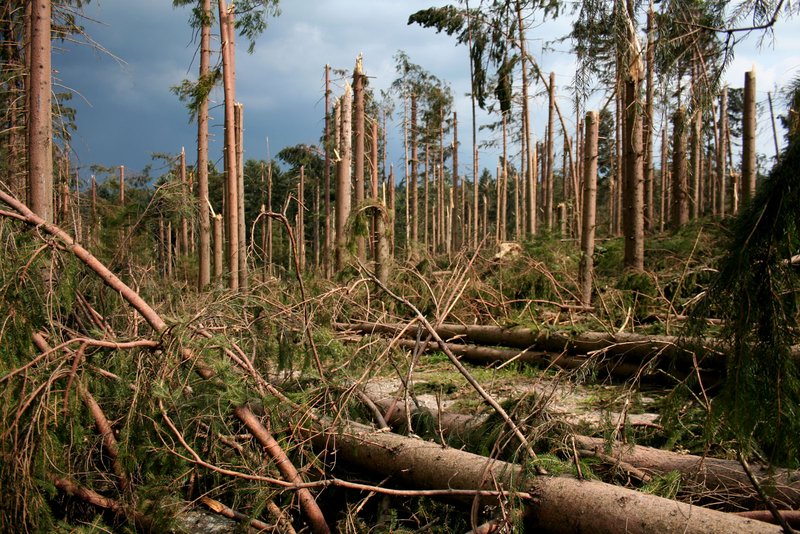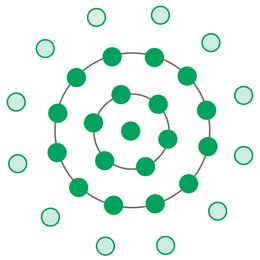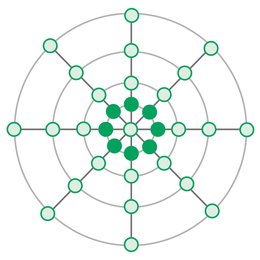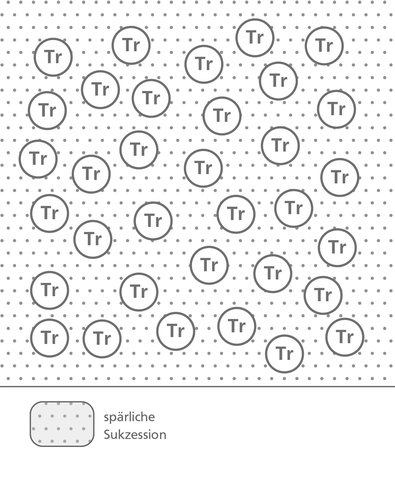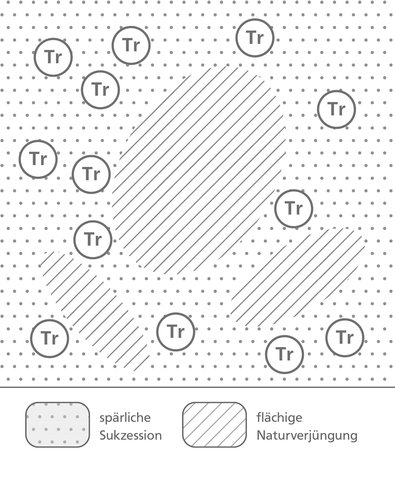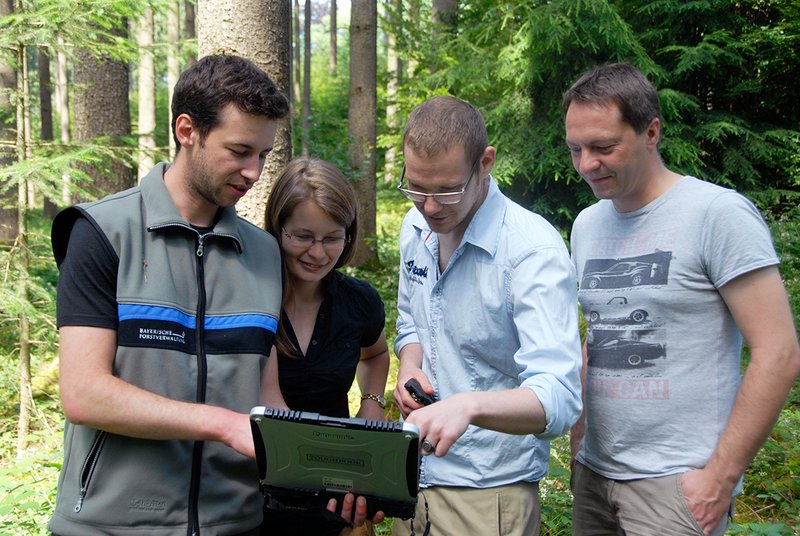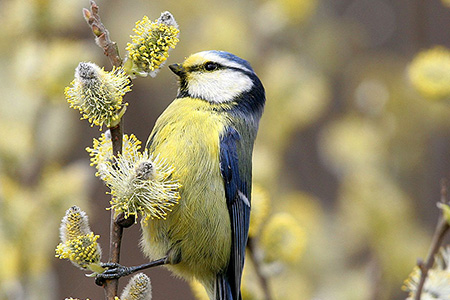Until just a few decades ago, tree species such as birch, alder, rowan, aspen and willows played very little role in practical silviculture. The natural regeneration of these softwood deciduous trees that cropped up on plantations was usually seen as an annoying side-effect - and it was removed early on, as the natural regeneration was thought to be taking up space and competing with the main tree species.
However, as close-to-nature forestry management has become established in recent decades, these pioneer tree species are increasingly being seen in a new light.
Their importance for nature conservation is certainly one thing that plays a role here. In addition to this, recent silvicultural studies have shown their value and pointed out potential new uses - and that their importance is likely to increase with the rise in clear areas resulting from calamities, and the increasing difficulty of establishing forest stands in dry years.
What characterises pioneer tree species?
Tree species that largely dominate in early stages of regeneration on open areas are called pioneer tree species. They share the following characteristics:
- They quickly take root naturally on clear areas - even when there are few old trees of their species nearby.
- They flower and bear fruit at a young age.
- They produce seeds almost every year and often in prolific numbers.
- Their seeds are dispersed easily by the wind, water or also animals.
- They are rapidly distributed and sometimes over very long distances.
- They have a low seed weight with only a small stock of nutrients to aid germination and establishment.
- They do not tolerate much shade.
- They are not demanding in terms of site requirements and can thrive well on open forest soil (mineral soil).
- They are hardy species in extreme conditions such as frost, strong direct sunlight and wind.
- They grow rapidly as juvenile trees and reach their highest annual increase in height and diameter at an early age (after 8 to 15 years).
- They usually have a short lifespan because their wood is not very resilient.
As well as relatively short-lived species such as birch, alder, willow, aspen and rowan - which we are going to talk about in this article - some longer-lived tree species such as larch, pine and the non-native robinia are also pioneer tree species. The characteristics of the pioneer tree species, especially their resilience in extreme conditions, give us good reasons to think that our forests might in fact benefit from an increase in the proportion of pioneer tree species in times of climate change. Or better still: these tree species might even play their part in solving silvicultural problems.
Softwood deciduous trees are adaptable
Studies have shown that pioneer tree species can adapt well in several ways to new challenges, such as those brought by climate change.
- Internal adaptation: Internal adaptation means that the genetic make-up of trees can adapt to changed environmental conditions. Softwood deciduous trees flower and produce fruit at an early age, producing a high number of seeds in the process. Pioneer seedlings are thus subject to strong genetic selection from the start. This allows them to adapt rapidly to new site conditions and climatic challenges.
- External adaptation: External adaptation means that a tree can adapt to the environment in its individual development. For it to adapt to climate change, its root development is crucial - both in terms of its diameter and its depth. Silver birch thus show more intensive root development under poorer conditions than on better sites. In order to produce better roots, they invest less in their sprout formation, however - so in other words, they adapt their shape to the new conditions. But of course, they cannot work wonders either.
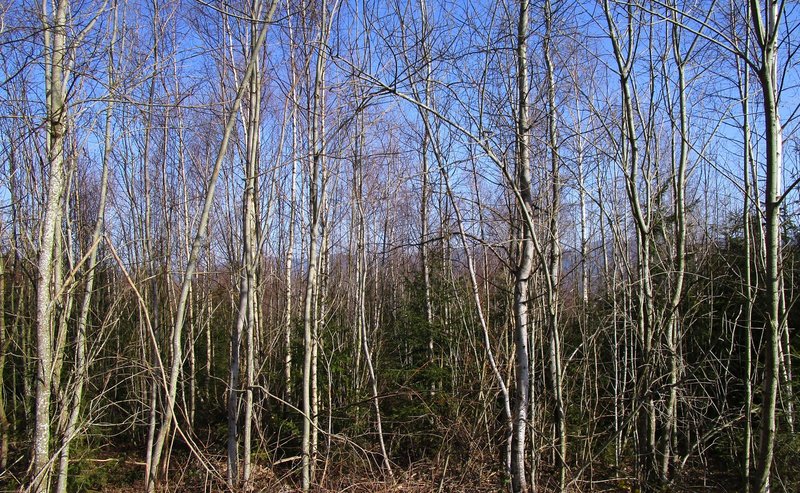
Fig. 2: Former windthrow area: Here, rich natural regeneration of aspen, birch, rowan and spruce has developed in the lower storey. The forest owner can now decide what he wants - and the tending measures he carries out determine the outcome: fuel wood production, shelter for the establishment of trees that do not thrive well on open areas, or quality timber production? (Picture: Wolfram Rothkegel, LWF)
Silviculture with pioneers
Nature is wasteful: every year, many times what we can sow artificially in terms of seed or young plants is dispersed in the form of seed over the forest. Research results from the studies on the development of damage areas after wind storms such as Vivian, Wiebke, Lothar or Kyrill show that forest areas - with very few exceptions - can redevelop all by themselves within a short period of time. And pioneer tree species play an important role in this. The diversity of tree species in this natural reforestation is sometimes astoundingly high. What is critical however, is that there is little pressure from browsing - or that the area is artificially protected. But how can soft deciduous woods be used in silviculture in concrete terms? In fact, there are various possibilities:
1. Using pioneer trees to shelter shade-loving tree species
One method that has been known for a long time but is seldom used, is to use soft deciduous woods to provide shelter for shade-loving tree species. This is suitable for clear areas. In this case, the soft deciduous wood that regenerates naturally is left, but the number of trunks is reduced through thinning measures to around 1.000 trees/ha. Under these pioneer trees, shade-loving tree species such as beech and fir can be introduced by planting during the given time period.
The pioneer crop protects the regeneration from frost and direct sunlight. Spruce natural regeneration usually develops in addition to this. Once the shade-loving deciduous trees are well established, the pioneer crop can be gradually removed, depending on the light requirements. However, some individual pioneer trees with good trunk formation can also continue to be encouraged and promoted to produce quality timber.
2. Ground cover and subsequent integration in targeted management measures
The most cost-effective way to create a new forest after events that have caused damage is to use the natural regeneration over the entire area. This develops whether the area has been completely or partially cleared, or not cleared at all. Pioneer tree species play an important role here. The requirements are that there must be sufficient seed trees available at the appropriate distance, that the accompanying vegetation is not too strong and that there is not too much browsing pressure.
High quality or valuable timber can also be produced with tree species such as birch, alder, rowan or even aspen. So a pioneer tree can certainly also become a target plus tree. The requirements for this are tree vitality and a good trunk formation, site suitability and a good prognosis in terms of the cultivation risk. It is crucial that the target or future crop trees are selected early and consistently and continuously promoted.
Pioneer trees in particular must be promoted consistently and very early, so that their crowns can develop properly at the right time. Trees with well-developed crowns also have a high growth. In this way, valuable timber can be produced on good sites relatively quickly – i.e. within 60 to 70 years. This allows clear areas to be quickly restocked. It has the added advantage that the soil is then also covered, thus preventing erosion and the leaching of nutrients. The risk of nitrate leaching into the ground water is also reduced. The regeneration of the forest, including its soil, is thus achieved naturally.
3. Solutions for gaps
Natural regeneration and the closing of gaps on damaged or barren areas often do not take place evenly. Even if pioneer tree species frequently become established over large areas, there are often patches in between without regeneration. This can be exploited for silvicultural purposes: gaps or areas with low numbers of plants can be actively used to introduce the desired, climate-tolerant tree species appropriate for the site, through so-called supplementary or enhancement planting measures. In this case, the main tree species are not planted over extensive areas, but in patches. There are various methods for doing this, such as planting in clusters, clumps or “Nelderräder” [small groups of trees planted in particular formations].
Fig. 3: Planting options for supplementary planting on succession areas: (From the left) circular cluster, square cluster, and “Nelderrad” method of planting in formation. The main tree species (target trees) are dark green; the secondary tree species (shade-tolerant deciduous trees and/or pioneer tree species) are light green. The diameters shown depend on the tree species: closer spacing for deciduous trees; wider for coniferous trees.
In the best case scenario, “cherries” in the form of small patches of target tree species to be promoted are distributed across the entire “cake” (area). These “cherries” need to be well marked and regularly monitored in subsequent years, because the tree species introduced there need to be intensively safeguarded and tended during the establishment phase and subsequent qualification and sizing stages. One advantage is the low cost of establishing the new culture, although there will normally be some investment in the continuous tending measures. During the tending measures, the pioneers immediately surrounding the target tree “cherries” have to be cut back far enough to allow the planted tree species to develop without restriction.
Fig.: 4: Possible silvicultural measures with pioneer trees (example scheme for around 1 ha of forest): left picture: as “fillers and quality drivers” in the qualification phase of final crop tree species introduced in clusters (“cherries”); or right picture: supplementary planting in gaps with sparse natural regeneration.
4. Integration of pioneers in regular cultures
Another alternative is to use pioneer tree species wherever gaps have appeared in cultures during the establishment phase. Instead of replanting, soft deciduous woods that arrive naturally in these areas can be used to close the gaps in the stand and thus also to promote the quality of the main tree species. If the gaps are not too big, other tree and shrub species such as elderberry, hazel and bird cherry can also be included to form temporary lower and intermediate storeys. This is also very valuable from the conservation point of view. In the subsequent sizing phase, these pioneers and woody shrubs can continue to be used as a lower storey and intermediate storey, contributing to the quality of the target trees. In the course of the consistent thinning to give light to the crown of the target trees, enough light usually passes through the canopy to allow the lower storey to grow as well, so that it can be used to promote trunk quality. If the conditions are right, this integration can be more ecological, cheaper and easier than retrospectively planting beech and lime, for example. There is also no danger of the pioneers growing into the crowns of target tree species later and competing with them, because of the limited light available.
Requirements for silviculture with pioneers
For a silvicultural strategy using pioneers to succeed, various things must however be considered. The two most important are:
- Game density and game browsing: To estimate how good the chances are of natural regeneration of pioneers becoming established, the area in question should be monitored closely from the early spring to see what germinates, what remains and what becomes established. It may be helpful to fence off small sample areas here, to show what can grow in areas not subject to browsing. When in doubt, protective fences surrounding extensive areas give pioneer trees a greater chance of becoming established over extensive areas than the protection of individual plants.
- Timing: Those managing the area should be clear on how fast the pioneer tree species are going to fill up the gaps in the area, and how strong the height growth in particular is. The necessary measures should be planned depending on these requirements.
It remains to be said that:
Pioneer tree species can have a positive influence on forest structure in times of climate change. They introduce a greater diversity of tree species, improve the quality of the humus and the nutrients situation in the soil, and they reach deeper into the forest soil. The advantages of pioneer tree species for biodiversity in the forest are undisputed. Pioneer tree species are however no wonder-cure or silver bullet solution to solve all problems. Especially on better sites, the proportion of pioneer tree species should not be too high.
Tip for reforestation: take your time
It is not possible and nor does it make sense in all cases to replant the whole area immediately after a disaster. The plants market, forest protection issues, financial resources and labour capacities may all limit the options available. Especially when it comes to the reforestation of larger areas after disasters, consideration should be given to making use of natural reforestation. It usually takes some time for natural regeneration to appear, however. It is thus advisable to monitor the area carefully for one to three years, and to take this time to think carefully about the objectives and possibilities, before deciding on the appropriate silvicultural measures to be taken. At the same time, the development of competing vegetation such as blackberry or reed grass (Calamagrostis acutiflora) must also be taken into account, however. On sites on which these arrive very quickly and grow strongly, natural reforestation will be delayed considerably or even prevented for a long time. Experiences made after the calamities of recent decades have shown that it can be both time-consuming and costly to act too quickly: in addition to the artificially introduced planted material, a large number of trees appeared through natural regeneration - which then had to be removed in costly tending measures in order to safeguard the planted stock. Close observation and local experience are thus required if wrong decisions are to be avoided.
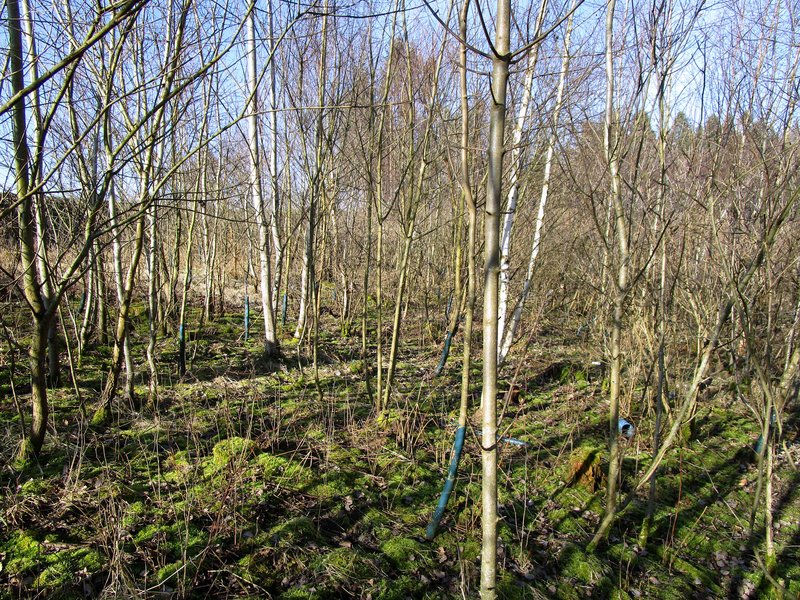
Fig. 6: Reforestation on a damage site: Of the planted maple saplings (with plastic spirals), around 800 trees/ha are still there after seven years, while around 4.600 saplings/ha of birch, aspen and willow have become established over the same period. It would have made more sense to work with nature here right from the beginning (Picture: Wolfram Rothkegel, LWF).
At a glance
- Pioneer tree species are being reassessed because of their properties in the face of climate change.
- Their robustness, rapid growth, and ability to adapt allow new opportunities, especially after disturbances in the forest.
- If pioneer tree species are to be used successfully, silvicultural measures must be objective-oriented, continuous and consistent.
- Pioneers are often a gift of nature, and they can be part of the solution when it comes to meeting silvicultural challenges. They are not however a cure-all solution to problems, as there are both site and climatic limitations on their use.

